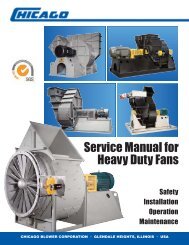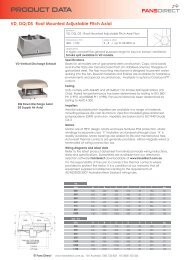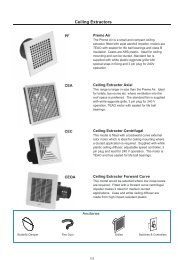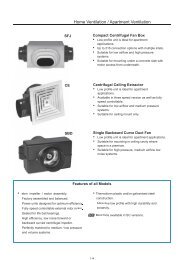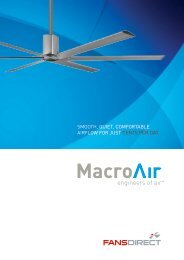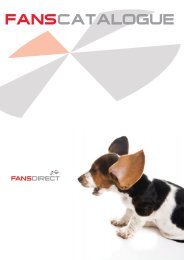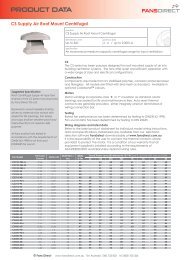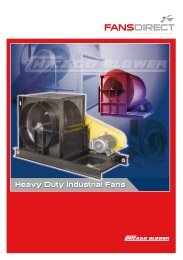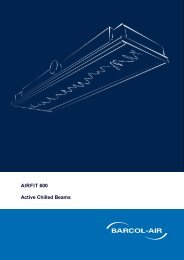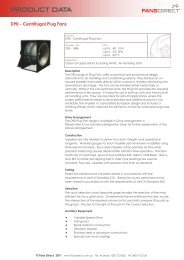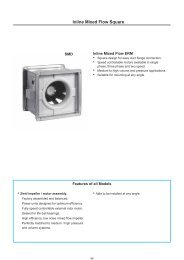Jet Fans - Fans Direct
Jet Fans - Fans Direct
Jet Fans - Fans Direct
Create successful ePaper yourself
Turn your PDF publications into a flip-book with our unique Google optimized e-Paper software.
Impulse Ventilation <strong>Fans</strong><strong>Jet</strong> Fan Ventilation for Car Parks andProduct SpecificationsJP - Series <strong>Jet</strong> <strong>Fans</strong>© Pacific HVAC Engineering 2013 www.pacifichvac.com Tel. Australia 1300 733 833 NZ 0800 100 326 1
JP Series <strong>Jet</strong> <strong>Fans</strong> - For Car Park VentilationINTRODUCTIONPacific HVAC Engineering is able to offer a complete solution in car parkventilation at a competitive price in partnership with Elektrovent, oneEurope’s largest and most experienced fan specialists.Car Park Ventilation Principles<strong>Jet</strong> fan systems are active systems offering a cost effective solution toventilate and extract smoke and pollutants, for example Carbon Monoxide(CO), from car parks. This ductless ventilation system provides either normalventilation or smoke extract in case of emergencies, or a combination ofboth.An efficient system requires good planning, starting with the physicaldimensions of the cark park, considering the pattern of utilisation as well aspeak loads. Ventilation rates are mostly based on an air exchange rate, or ona rate multiplied with the number of parking spaces.A <strong>Jet</strong> Fan system offers the “ventilation on demand” principle for car parks,depending on measurements by CO sensors. <strong>Jet</strong> <strong>Fans</strong> can be individuallycontrolled, or grouped together in fire zones. In fire mode, after a pre-setstandstill escape period, the jet fans will run at full speed to quickly andeffectively clear smoke.BenefitsThe space saving design, compared to a standard duct based ventilationsystems, offers a variety of benefits:• It is possible to ventilate or extract smoke in particular sections ofthe car park. CO (carbon monoxide) and smoke sensors ensurethat only fans in polluted areas are activated and the fans areswitched into smoke extract mode immediately if a fire starts.• No expensive, bulky and complex duct systems, making it an idealsolution for renovations.• Car park design is more attractive.• Improved air quality in car parks compared to conventionalducted systems.• Optimum safety is provided in case of a fire in the car park. Rapidsmoke extraction, smoke cooling, limited smoke spread, i.e. bettersmoke control.• <strong>Jet</strong> Fan systems for smoke extract prevent costly consequentialdamages in case of a fire: the ceilings are subjected to less heat,and smoke is quickly removed from the building.• More flexible in re-positioning when the parking area is redesigned.• Energy saving in exhaust air fans due to reduced system resistance(no duct systems).• Reduced installation and running costs.BCA And The Requirements of AS/NZS1668.2The use of an appropriately designed <strong>Jet</strong> Fan system is deemed to meet therequirements of the Building Code of Australia (BCA) and comply withAS/NZS1668.2 provided there is evidence to support the efficacy of theinstalled system. Evidence of the system function and compliance isproduced in the form of computer generated models (Computational FluidDynamics Analysis) simulating air flows within the structure.2 © Pacific HVAC Engineering 2013 www.pacifichvac.com Tel. Australia 1300 733 833 NZ 0800 100 326
JP Series <strong>Jet</strong> <strong>Fans</strong> - For Car Park VentilationINTRODUCTIONBCA And The Requirements of AS/NZS1668.2 (Continued)In order to perform a CFD analysis, it is essential to have a 3-Dmodel of the building site, giving all openings, slab height, surface of theceiling (flat or with drop beams, dimensioning of the drop beams, etc.)and all other details required to carry out a simulation.A CFD analysis is used to simulate the airflows, to ensure that the distributionof the air is sufficient to effectively ventilate the cark park under normalconditions as well as in emergency situations. The analysis references allaspects of the design of the structure and the emissions concentrationscalculated for the intended usage loads of the building. The CFD reportillustrates the number and placement of <strong>Jet</strong> <strong>Fans</strong> taking into account thebuilding design and structural obstacles.Pacific HVAC Engineering is able to facilitate the preparation of CFD Reportson a project by project basis. Costing is quoted taking into account the scaleas well as complexity of the project.Control SystemsA control system is required, which is tailored to handle the requirements ofthe specific project for ventilating and smoke extraction. An effective controlsystem saves energy by reducing the ventilation rate with the help of COsensors, depending on the car park usage, increasing ventilation rate only inpeak hours and operating the jet fans only selectively, according to demand.When used for smoke extract, the system has to work on a fire detectionsystem (heat or smoke detection). In car parks with different levels, thesystem has to run the jet fans full speed on the fire level, and simultaneouslyswitch off the fans in all other levels. The main exhaust air fans are switchedto full speed. The control equipment regulates the main supply and/orexhaust fans together with the jet fans, both depending on thesignals coming from the sensors.Note: Owing to the complex nature of control systems generally and moreprecisely the integration of ventilation and smoke control systems withBuilding Management Systems (BMS), Pacific HVAC Engineering is not able tofacilitate control system design for projects.JP CENTRY - SeriesLow Profile Centrifugal Impulse <strong>Fans</strong>.JP DUCT - SeriesAxial Impulse <strong>Fans</strong>.© Pacific HVAC Engineering 2013 www.pacifichvac.com Tel. Australia 1300 733 833 NZ 0800 100 326 3
JP-DUCT AXIAL Hi Temp Series <strong>Jet</strong> <strong>Fans</strong>F200 (Rating 200°C / 120 minutes)F300 (Rating 300°C / 30 minutes)SPECIFICATIONSDescriptionJP-DUCT Series <strong>Jet</strong> <strong>Fans</strong> are axial impeller types with smoke spillcertification to AS/NZS4429:1999.RangeThree impeller sizes : 315mm, 350mm, 400 mm.Motors are 2 pole single speed and 2/4 pole double polarity, tappedwinding.Speed control for two speed motors is via switching or VSD (highspeed only). Single speed motors can be controlled with VSD’sAvailable VersionsUni <strong>Direct</strong>ional (JP-DUCT/U)Reversible Airflow (JP-DUCT/R) .Standard for operation up to +40°CSmoke exhaust operation 200°C/120’ (F200) certified AS/ZS4429:1999.Smoke exhaust operation 300°C/30’ (F300) certified AS/NZS4429:1999.ConstructionCases are formed from corrosion resistant galvanised sheet. Impellersare high efficiency die cast aluminium alloy with aerofoil bladesbalanced according to ISO1940.Motors are asynchronous three phase types with IP55 rating.Voltage / Frequency; 4015V/50 Hz.DimensionsSize A B1* B2 C1* C2DEFGHI315 1660 410 465 360 250352-31540063080355 1800 445 510 400 250352-36040070080400 2000 495 560 450 25035284841040080080PerformanceFan Model Thrust N Air Flow m 3 /h Motor k/W Air Speed m/s Amps RPM dB(A)@ 3m kgJP-DUCT/U 31-2 27 4,600 0.7517 1.5 2,820 59 67JP-DUCT/U 31-2/4 27 / 6.7 4,600 / 2,300 0.8 / 0.2 17 / 8.5 2 / 0.6 2,820 / 1,400 59 / 44 67JP-DUCT/U 35-2 35 6,000 1.117 2.3 2,820 61 75JP-DUCT/U 35-2/4 35 / 8.7 6,000 / 3,000 0.2517 / 8.5 2.4 / 0.7 2,810 /1,400 61 / 46 75JP-DUCT/U 40-2 61 9,000 1.520 3.5 2,850 62 90JP-DUCT/U 40-2/4 61 / 15.30 9,000 / 4,500 1.5 / 0.35 20 / 10 3.5 / 1.2 2,850 / 1,452 62 / 47 90JP-DUCT/R 31-2 20 4,000 0.7514.6 1.5 2,820 59 68JP-DUCT/R 31-2/4 20 / 5 4,000 / 2,000 0.8 / 0.2 12 / 6.15 1.9 / 0.6 2,820 / 1,400 59 / 44 68JP-DUCT/R 35-2 35 6,000 1.117 2.3 2,820 61 76JP-DUCT/R 35-2/4 35 / 8.7 6,000 / 3,000 0.2517 / 8.5 2.4 / 07 2,810 / 1,400 61 / 46 76JP-DUCT/R 40-2 54 8,500 1.518.7 3.5 2,850 62 92JP-DUCT/R 40-2/4 54 / 13.5 8,500 / 4,250 1.5 / 0.35 18.7 / 9.35 3.5 / 1.2 2,850 / 1,425 62 / 47 922 suffix = 2 Pole Single Speed Motor. 2/4 suffix = two speed motor, 2 and 4 pole. U/ = Single direction flow. R/ = Reversible direction flow.4 © Pacific HVAC Engineering 2013 www.pacifichvac.com Tel. Australia 1300 733 833 NZ 0800 100 326
JP-DUCT AXIAL Hi Temp Series <strong>Jet</strong> <strong>Fans</strong>F200 (Rating 200°C / 120 minutes)F300 (Rating 300°C / 30 minutes)Discharge PatternsMaximum air speed 2 m/sMaximum air speed 4 m/s© Pacific HVAC Engineering 2013 www.pacifichvac.com Tel. Australia 1300 733 833 NZ 0800 100 326 5
JP-CENTRY Hi Temp Series <strong>Jet</strong> <strong>Fans</strong>F300 (Rating 300°C / 30 minutes)SPECIFICATIONSDescriptionJP-CENTRY Series <strong>Jet</strong> <strong>Fans</strong> are centrifugal impeller types with smokespill certification to AS/NZS4429:1999. The JP-CENTRY models areparticularly useful where head clearances are restricted.RangeTwo models - 50N and 100N capacities.JP-CENTRY254/8 (50 Newton)JP-CENTRY314/8 (100 NewtonMotorsMotors are 4/8 pole asynchronous three phase types with IP55 rating.Speed control for two speed motors is via star / delta switching.Voltage / Frequency; 4015V/50 Hz.Smoke Spill RatingSmoke exhaust operation 300°C/30’ (F300) certified AS/NZS4429:1999.ConstructionCases are formed from corrosion resistant galvanised sheet. Impellersare high efficiency backward curved types fabricated fromgalvanised steel sheet balanced according to ISO1940.DimensionsModel A B C D E F G H IJP-CENTRY254/8 870 515 250 1200 25 830 186 740 900JP-CENTRY314/8 1030 460 305 1450 25 1000 240 850 1070PerformanceFan Model Thrust N Motor k/W Air Speed m/s Amps RPM dB(A)@ 3m kgJP-CENTRY254/8 50 / 25 1.2 / 0.3 23 / 11 3.3 / 1.4 1400 / 700 68 / 60 67JP-CENTRY314/8 100 / 50 2.2 / 0.55 28 / 13.5 5.8 / 2 1400 / 700 68 / 59 994/8 suffix = two speed motor, 4 and 8 pole.6 © Pacific HVAC Engineering 2013 www.pacifichvac.com Tel. Australia 1300 733 833 NZ 0800 100 326
JP-CENTRY Hi Temp Series <strong>Jet</strong> <strong>Fans</strong>F300 (Rating 300°C / 30 minutes)Discharge PatternsMaximum air speed 13 m/sMaximum air speed 8 m/sMaximum air speed 5 m/s© Pacific HVAC Engineering 2013 www.pacifichvac.com Tel. Australia 1300 733 833 NZ 0800 100 326 7



